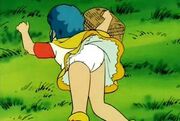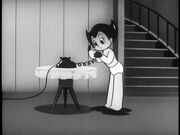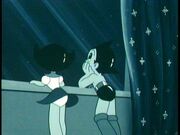
Panchira: one of the defining elements of Japanese popular culture.
Panchira (パンチラ) is a term used by Japanese women to warn each other that their underwear is visible, similar in context to the English expression "your slip is showing." The word may be described as a portmanteau of "panty" (パンティー, pantī) and "chira," the Japanese phenomime representing a glance or glimpse, and carries both humorous and risque connotations.
In relation to anime and manga, the term refers to an image in which a female character's briefs are exposed for any length of time (in contrast to the original meaning, which stipulates a brief 'flash' of undergarment). In English usage, the term has become almost synonymous with 'upskirt', and is considered the most common form of fanservice in Japanese animation. Panchira also plays a significant role in video game software, particularly in dating sims and visual novels.
Anime[]

Gratuitous panty shots were a regular feature of early Japanese TV animation.
In practice, panchira has been a convention of Japanese cartoons since (at least) the early sixties, when young girls (shoujo) were frequently portrayed with abbreviated hemlines. The convention was almost certainly adapted from American comics and cartoons; Japanese animators synthesized many stylistic elements common to Western 'toongirls', reinterpreting them for early shoujo characters.

One of the best-known examples was Uran from Osama Tezuka's Astro Boy (Studio Mushi 1963); like her American predecessors, Uran-chan was designed with an upswept skirt, leaving her plain white briefs on open display. As Uran served as a template for many later female characters, panchira became standard practice within the medium — a defining principal, in fact, still employed to the present day.
Throughout the sixties, panty-shots were comparatively innocent, restricted mainly to school-aged girls (such as Mahou Tsukai Sally or Akane-Chan) - most probably because depicting a teenaged or adult woman in sexual terms would have been inappropriate at that time. Later characters, such as Mimiko from Hayao Miyazaki's Panda! Go Panda! employed the panty shot for light comedy relief; but by and large, panchira was a simple visual convention, devoid of all sexuality. However, the turn of the decade would introduce a number of changes to the basic formula.
Biology reference[]


Early 70's sexuality: Tezuka's Marvelous Melmo.
During the late sixties, the practice took on overtly voyeuristic overtones with the publication of Go Nagai's Harenchi Gakuen. Set in a high school overrun by perverts and psychopaths, Nagai's controversial manga was the first to depict teenaged girls in unambiguously sexual terms, breaking numerous social taboos and generating major dissent in the Japanese press. Panchira played a crucial role in the series; storylines often revolved around skirt-flipping (sukato meguri), and students were frequently depicted in their underwear (or less). Much of the sexual imagery would be considered tame by modern observers, but such depictions were considered shocking by the standards of the time.
Nagai's influence quickly spread to the animation industry with the debut of adolescent heroines such as Mahou no Mako-Chan (Toei Animation, 1970) or Cutie Honey (Toei Animation 1973, adopted from Nagai's manga of the same name).

It was around this period that animation studios began targeting teenagers and young adults, leading to a prevalence of upskirt takes, panty-shots and gratuitous bathing scenes. Panchira was incorporated into every genre of the artform, from Magical Girl fantasy series to sci-fi action/adventures (one of the more explicit series of the time - Marvelous Melmo - was actually used to teach sex education in Tokyo elementary schools as early as 1971).
As the decade wore on, sexual referencing became increasingly commonplace in anime, eventually leading to the development of ecchi comedies and mildly risque series such as Maicching! Machiko-Sensei (see below). Strangely, while various degrees of nudity had existed in television animation for several years, panchira still took precedence in the mainstream - due, perhaps, to the long association of panty shots with bishoujo anime - cartoons about pretty young girls.
Ecchi comedy[]

The 1980s saw an expansion and diversification in Japanese animated media, establishing anime as a recognised artform (at least within Japan). Targeting a more adult demographic, various studios began pushing the limits of mainstream fanservice. Prime-time television series - including children's cartoons - could now be unambiguously sexual, engaging in farcical humor and patently ribald scriptwork. The debut of Maicching! Machiko-Sensei (Studio Pierrot) in 1981 took fanservice to an entirely new level, offering an endless parade of double entendres, gratuitous stripteases and nude shower scenes.

Other studios soon followed suite, and ecchi comedy began to appear in even the most unlikely places, such as the popular 'ninja high school' (Sasuga no Sarutobi) genre or Children's fantasy series (Gugu Ganmo). Significantly, this was the same period in which the stereotype Japanese schoolgirl (joshikosei) began to flourish in anime. Joshikosei were usually depicted with white cotton briefs; a direct reference to the Tezuka years, when shoujo characters invariably wore plain white undergarments.
Sukebe Otaku![]

Japanese popular culture gained a substantial foothold in the Western market during the 1990s due to numerous factors, including the popularity of the World Wide Web or the rapid assimilation of anime into American TV (examples of which included Toei's Sailor Moon in 1992). Panchira was one of the many visual imports that arrived in the States via the internet, initially in the form of individual scans and screencaps.

Improvements in peer to peer software (such as Bittorrent or eMule), allowed users to download entire animated series to their desktops, along with Ero games, KiSS dolls and other media formerly unavailable outside of Japan. Similarly, the development of wakata script in Japan had an almost immediate impact in the West. Multiple imageboard sites like 2channel were meticulously copied by American users, resulting in the creation of online communities such as 4chan. Allowing for anonymous posting and the mass uploading of graphic media, Chan sites attracted an enormous following of anime enthusiasts, gamers, fan artists, trolls and obsessives collectively referred to as otaku (after a Japanese term meaning 'shut-in'). In some cases, entire boards were dedicated to panchira in manga, anime and CG, as was the case with the Pantsu board on WAKAchan.
Japanese animation studios had been producing adult-oriented anime since the late 80s, and were quick to capitalize on the growing otaku subcultures on both sides of the Pacific. Direct-to-video features were released to the international market; most featured varying degrees of fanservice. A number of 'limited' TV series focused specifically on risque humor: Najica: Blitz Tactics (2001), Love Love? (2004) and Smash Hit (2004) all featured unprecedented amounts of panchira. One of the earlier entries, Agent Aika: Naked Missions, (1997) contained one panty shot every 20 seconds.
Gallery[]
Example anime series[]
- Akane-chan
- Creamy Mami
- Cutie Honey
- Fushigina Melmo
- Gatchaman
- Magical Emi
- Magical Fairy Persia
- Mahou no Mako-chan
- Mahou Tsukai Sally
- Maicching! Machiko-sensei
- Majokko Megu-chan
- Panda kopanda!
- Pastel Yumi
- Reindeen the Brave
- Tetsuwan Atom


